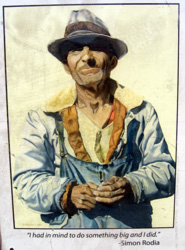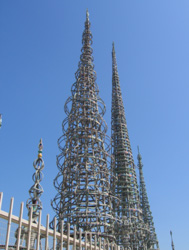See: WRITERS & TRASLATORS, Leo Politi
Italians have a centuries-old artisan and hand-craft tradition (material arts) which embraces a variety of media from stone, marble, ceramic tile, and gesso, to wood, and paint, including such art forms as: murals and frescoes, faux marble (and other trompe líoeil), intarsia, mosaics, cameo carving, sculpting in wood or marble, plaster cast figurines. Other media such as textiles, wax, straw may be used in the domestic arts: embroidery, palm-weaving, decorative foods, ritual displays (e.g., altars, yard shrines). Many of these are alive and well, while others are waning. Names associated with cameo-carving and faux marbling (cf. St. Peter's Church), are Giovanni Palomba, decorative plasterwork as well as figurines, Arbace Bracci and sons (c/o Garibaldina Society). Wherever Italians have settled, their skills in artisan or hand-crafted traditions have been primary. A comprehensive survey of such artisans has yet to be completed.
Italians also held key roles in the construction industry. Their names were common among Los Angeles companies (e.g., as Pozzo, builders of Italian Hall, St. Basil's church). An Italian's family and home are among his/her greatest treasures. The home is therefore invested with great love, effort, and expense. Once-common embellishments took the form of yard fountains, statues, decorative wrought-iron, and are sometimes still found. Some are more utilitarian, such as a home-build outdoor ovens or barbecues, fruit & vegetable gardensólabors of love often created with one's one hands, and serving specific cultural needs. And inside Italian American homes one easily finds typically Italian materials such as marble and ceramic tile, not to mention decorative arts which go from Baroque to the latest imported furniture and other items of contemporary design. (See: ART & ARCHITECTURE, Art, Interior Decor). Indeed, imported marble and tile companies have lately sprouted around the Southland, as these materials become more commonly used (See: ART & ARCHITECTURE, Architecture, building: Stone and Tile).
Further reading:
Luisa Del Giudice, "The 'Archvilla': An Italian Canadian Architectural Archetype," in L. Del Giudice, ed., Studies in Italian American Folklore, Logan: Utah University Press, 1993:53-105.
Hobbie, Margaret, Italian American Material Culture: A Directory of Collections, Sites, and Festivals in the United States and Canada, Greenwood, 1992.
Joseph Sciorra, "Imagined Places, Fragile Landscapes: Italian American Presepi (Nativity CrËches) in New York City," in, The Italian American Review (A Special Issue on Italian American Folklore, Vol. 8, No. 2, Autumn/Winter2001: 141-174.
Public Folk Art: The Watts Towers
[Excerpt from: Kenneth Scambray, ìCreative Responses to the Italian Immigrant Experience in California: Baldassare Forestiere's "Underground Gardens" and Simon Rodiaís "Watts Towers," in The Italian American Review, Volume 8, Number 2, Autumn/Winter 2001: 131-32. Reproduced by permission. All Rights Reserved.]
 The commemorative plaque of Rodia, creator of the Watts Towers. |
"Light and the abundance of space were central to the form and content of Simon Rodiaís Watts Towers. In 1921 he purchased a house on a wedge-shaped lot with a spacious side yard, like most Southern California residential homes. Light would be an important aspect of the materials he selected to festoon his seventeen different sculptures, including three towers standing between fifty-five and nearly one-hundred-feet tall. He collected fragments of glass, pop bottles, pottery, cups, plates, automobile glass, window glass, mirrors, bottoms of bottles, teapots and tiles, as well as seashells he gathered during his walks on Southern California beaches. The tiles, whole and fragments, came from a variety of manufacturers in Southern California. He placed these in bins on the site and carefully selected the fragments for their placement. He kept a fire burning on the back of his property where he melted glass into free forms before he embedded them into the walls of his sculptures. He used household and industrial objects to press designs into his drying mortar, from the backs of ice cream parlor chairs, wire rug beaters, and faucet handles, to gears, iron gates, grills, baskets, and cooking utensils. He poured mortar into cast-iron corn bread bakers, removed the dried mortar, and inserted the panels into his sculptures. On other surfaces he inscribed freehand designs into his wet mortar. Into sections of his exterior wall, he pressed images of his toolsóhammers, pliers, and filesósigns of his immigrant working class values.
 Sabato (Sam or Simon) Rodia's Towers, in Watts |
But Rodia's site is not just a random collection of junk. It is a controlled work created from the many carefully selected materials collected from his surroundings. As the Southern California light passes over the multicolored surfaces of his sculptures during the day, it creates a polyphonic luminosity. The combination of free-form glass and tile fragments reflect the Southern California light in inharmonic tones and shades. The elongated, arched buttresses that crisscross the site and that also form the round circles on the towers cast a network of changing shadows across the site. Like Southern California around it and like Rodia's own life, the sculptures are not static. They change with the movement and intensity of the sun. Though made of reinforced concrete, the giant towers appear light and airy, more celestial than earth bound."
Of related interest: "I Build the Tower": The Passion of Sam Rodia, film on the Watts Towers of Sam (a.k.a. Simon) Rodia by Edward Landler and Brad Byer, Bench Movies, 2005. http://www.ibuildthetower.com/
Watts Towers Arts Center
1761-1765 E 107th St.
Los Angeles, CA
Tel: (213) 847-4646
Fax: (323) 564-7030
E-mail: cadwattsctr@earthlink.net
http://www.wattstowers.us
The Friends of Watts Towers Arts Center: Formed in 1983, revived in 1996 to support and promote the Arts Center, through advocacy, fundraising and community outreach. They produce the annual Jazz Festival and Day of the Drum festival. Tel: (213) 847-4646, www.wattstowers.net
Watts Towers Guardians (Committee for Simon Rodiaís Towers in Watts ñ CSRTW): Founded in 1959 as a guardian group to preserve and exhibit Rodiaís towers so that public access can be maintained, and to advise state and local officials on their restoration and maintenance efforts. E-mail: WattsTowers-Guardians@mailstation.com
Watts Towers Community Action Council: Formed in 1985 by the community to develop the Cultural Crescent Project, and to support and promote the activities of the Arts Center.
Mayorís Task Force: Established in 2005 to address the issues and continuing well-being of the entire Watts Towers campus.
